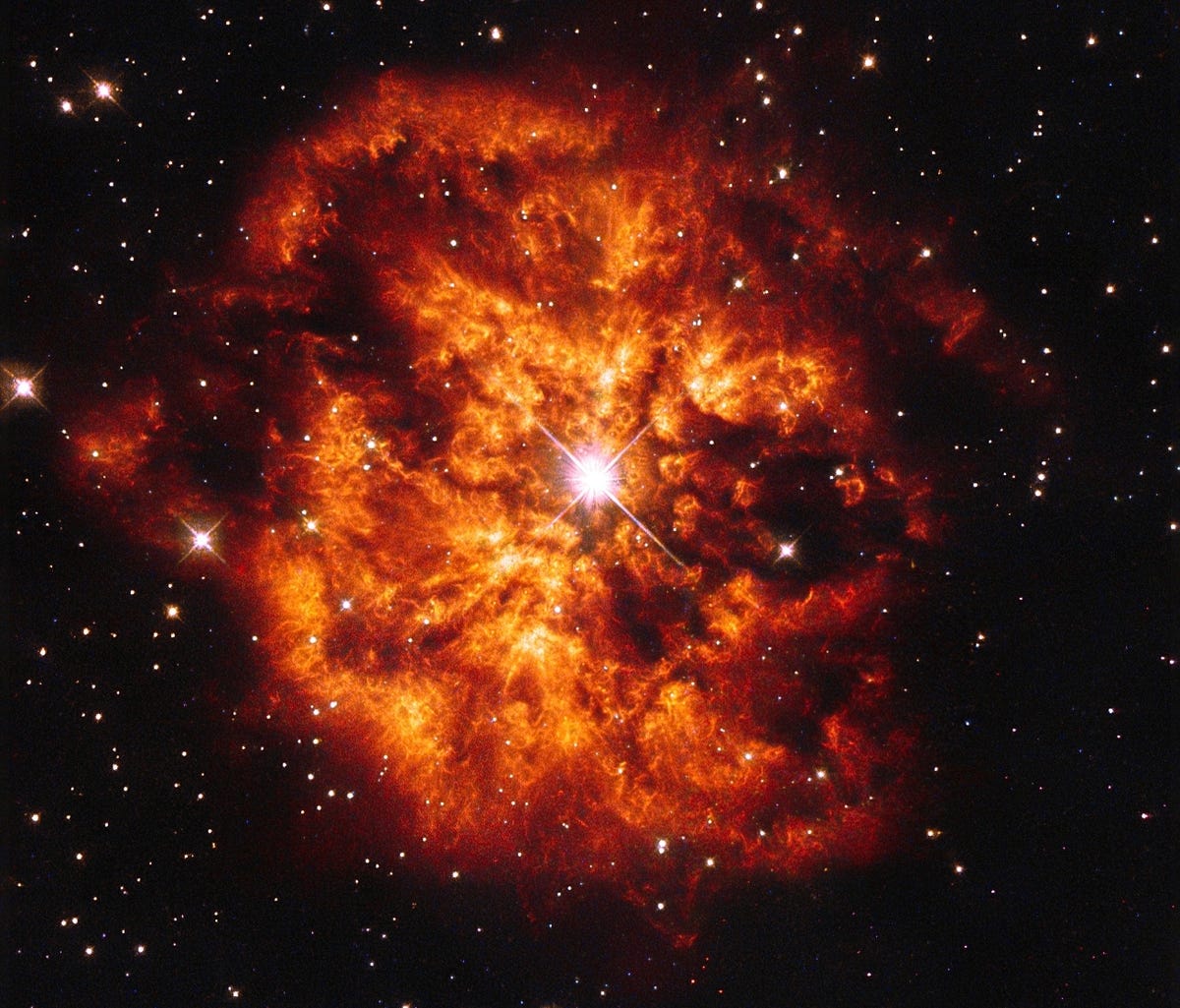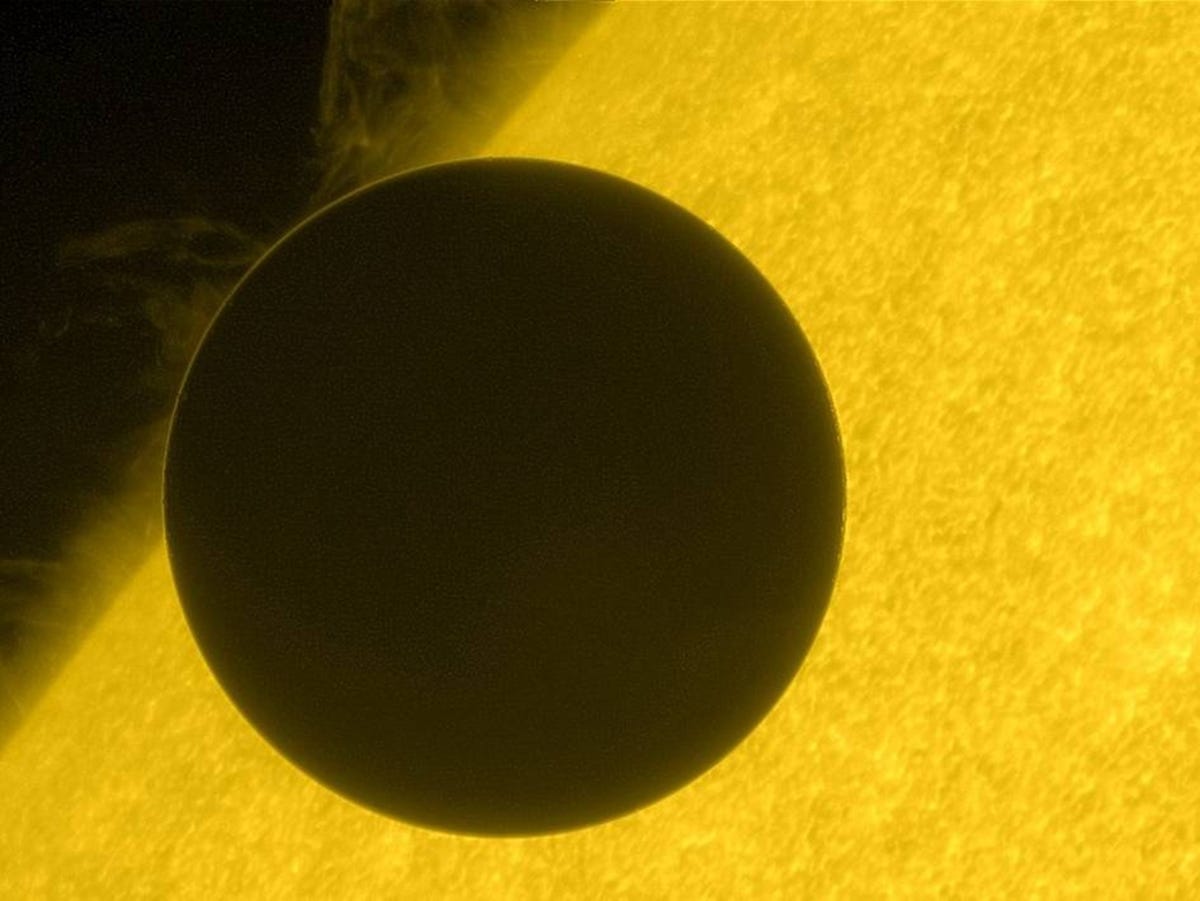Best space photographs of 2015
Humanity has achieved a number of incredible space milestones and discoveries this year, and we've seen some stunning images from space. Here's a selection of our favourites.

Runaway star
This stunning nebula is being blasted outwards from the star at its core, WR 124, a Wolf-Rayet star that burns very hot, very bright and very quickly. WR 124 is also a renegade, rocketing through space at a speed of 200 kilometres per second (125 miles per second).
Shimmering jets
A new image picks out the details inside the wings of nebula PN M2-9, the Twin Jet Nebula. The jets are being shed by a star at its core as it ends its life, but the unusual shape is caused because it's a binary star. As the stars orbit each other, they shape the flow of the expanding nebula.
Collision aftermath
This spiral galaxy is all bent out of shape in the aftermath of a collision with another galaxy. Its structure is all messed up, and those pink patches are regions of furious stellar formation created by the merging gas pockets of the two galaxies.
Sparkling lagoon
A new photo of the Lagoon Nebula, also known as Messier 8, shows it in greater detail than ever before. At its heart, star formation and stellar winds carve out shapes in the dark dust.
Peeking at Titan
Saturn's moon Titan has a hazy atmosphere, which makes the surface difficult to see on the visible spectrum. Composite images of the surface were taken by Cassini's near-infrared spectrometer, which can penetrate the clouds.
Opportunity says hello
Curiosity is doing great work, but 2015 marked rover Opportunity's 11th year on the Red Planet. It's still out there, busily working away. This photo, taken in March, shows its robotic arm examining a rock formation.
Mangalyaan
We've seen plenty of pictures of Mars, but this one is something really special. It was taken by India's Mars orbiter, Mangalyaan, a project that cost just $74 million, compared to NASA's $671 million for Maven.
Water flowing on Mars
The now-famous picture should need no introduction. It shows the runnels and rivulet tracks called "recurring slope lineae" that indicate the presence of flowing salt water on Mars.
A gravitational magnifier
Gravity in space is so strong that it can bend light, which works like a sort of magnifying lens and lets astronomers see objects in greater detail. This one has split a supernova into four, a phenomenon known as Einstein's cross, allowing researchers to observe it at different times.
Happy birthday, Hubble Space Telescope
In April of this year, the Hubble Space Telescope celebrated 25 years in operation. To commemorate the occasion, this gorgeous photo of the giant, 3,000-star cluster Westerlund 2 inside the Gum 29 nebula was released. It shows the home of some of the Milky Way's hottest, brightest stars.
Hello Pluto
After nearly a decade in transit, space probe New Horizons finally arrived at dwarf planet Pluto this year, giving us the best look of the tiny outlier we've had to date. Of all the photos sent back, this one is the one that makes Pluto seem most real to me, showing the surface's detailed terrain.

Transit of Venus
The transit of Venus in front of the sun is a rare event in the solar system. The last time it happened was in 2012. This year, NASA released a paper containing the details they were able to glean from studying Venus' atmosphere as it was back-lit by the sun. The next such transit won't happen until 2117.
Triple crescents
Saturn probe Cassini has captured some stunning photos of the planet's moons during its years in operation. My favourite this year is this snap of Titan, Rhea and Mimas.
A bright mystery
Space probe Dawn arrived at dwarf planet Ceres in the asteroid belt between Mars and Jupiter earlier this year, capturing a strange patch of shining brightness in the Occator crater. For most of the year, the patch remained a mystery, but early in December it was announced that it is probably a salt flat.
Comet party
Last year, ESA scientists landed a probe on a comet, a masterpiece of navigation. As Comet 67P/C-G reached its closest point to the sun this year, Rosetta was on hand to photograph the jets of gas and dust shooting from the surface of the heating chunk of rock.
The vast Milky Way
This may not look like much, but it's huge. Literally. It's the largest photograph of the Milky Way ever taken comprising some 46 billion pixels and 194GB. Using it, Ruhr University Bochum's astrophysics department has identified at least 50,000 new variable objects to date.
Peering through space
Nebulas obscure what's behind them with light and dust. Using the near-infrared capabilities of the VISTA telescope in Paranal, Chile, the European Southern Observatory was able to locate two new Cepheid variable stars behind the Trifid Nebula.
A cold mouth
CG4, or the God's Hand Nebula, is very cold and very dark, but new stars are forming in the stellar nursery at its core. In this Very Large Telescope image, the tiny nebula is illuminated by the stars around it.
Homing in on Enceladus
Enceladus joined the list of potential places to find extraterrestrial life with the discovery of a liquid ocean beneath its icy surface. Cassini also conducted a close flyby, confirming features such as fractures on the Saturnian moon's surface.
Through the veil
This beautiful picture of a tiny section of the Veil Nebula shows in intricate detail the wisps and filaments that are the only remnants of an exploded star.
Cosmic sunflower
Galaxy Messier 63, located some 27 million light-years away, is also known as the Sunflower Galaxy. Its spiral arms and the parastichies of a sunflower's heart both follow the curves of a perfect golden spiral... on wildly different scales, of course.
Stellar smile
Sometimes gravitational lensing splits a supernova into four, and sometimes it bends light in such a way that creates the illusion of a smiley face among the stars.
The moon and the space station
Australian astrophotographer Dylan O'Donnell planned for an entire year before capturing this stunning shot of the ISS in transit across the full moon. The conditions had to be exactly right, and the transit took just 0.33 seconds, so the feat is pretty amazing.
Followed by a moon shadow
In January, the Hubble team captured a rare event: three of Jupiter's moons in transit across the gas giant at the same time. In the image series, you can make out Callisto, Europa and Io as well as their dark shadows on Jupiter's atmosphere.
Andromeda in detail
The Hubble Space Telescope spent years, from 2010 to 2013, snapping pictures of a section of the Milky Way's closest neighbour, the Andromeda galaxy. It released the final mosaic in January this year. At just 61,000 light years across, this section contains over 100 million stars and is the most detailed image of the Andromeda galaxy obtained to date.
The Pillars of Creation
One of the most iconic and well-known space features is the Pillars of Creation, a glorious configuration in the Eagle Nebula so named for its three large columns. Early this year, NASA announced a new shot taken by Hubble, revisiting the famous 1995 photo in glorious high definition.
A star is born
A pair of powerful jets shoot out from a protostar and its accretion disc in Herbig-Haro object 212 located in the constellation of Orion. This image was captured by the ESO's Infrared Spectrometer And Array Camera, now decommissioned.
Old as time
This image comprises just a tiny section of the sky, but it contains some of the oldest and faintest galaxies in the universe. This includes Tayna, the oldest galaxy seen to date. Researchers calculate that it was formed just 400 million years after the Big Bang.
Alien skies
Nothing makes Mars seem more alien than its sunset, which, in contrast to Earth sunsets, occurs in cool blue hues. This is because the thin Martian atmosphere contains dust particles that allow blue light to penetrate more efficiently when the sun is low on the horizon.
Map to a neutron star
The colourful halo surrounding this object isn't visible to the naked eye. It's the echoes of light from X-ray bursts emanating from a dying star, which reflects off dust clouds and is imaged using radio and X-ray data. These X-rays are unusual because they're usually only seen coming from black holes.

